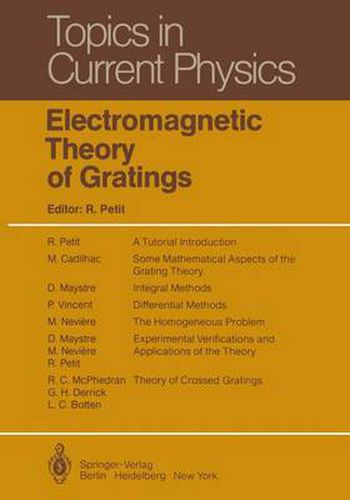Readings Newsletter
Become a Readings Member to make your shopping experience even easier.
Sign in or sign up for free!
You’re not far away from qualifying for FREE standard shipping within Australia
You’ve qualified for FREE standard shipping within Australia
The cart is loading…






This title is printed to order. This book may have been self-published. If so, we cannot guarantee the quality of the content. In the main most books will have gone through the editing process however some may not. We therefore suggest that you be aware of this before ordering this book. If in doubt check either the author or publisher’s details as we are unable to accept any returns unless they are faulty. Please contact us if you have any questions.
When I was a student, in the early fifties, the properties of gratings were generally explained according to the scalar theory of optics. The grating formula (which pre dicts the diffraction angles for a given angle of incidence) was established, exper imentally verified, and intensively used as a source for textbook problems. Indeed those grating properties, we can call optical properties, were taught'in a satisfac tory manner and the students were able to clearly understand the diffraction and dispersion of light by gratings. On the other hand, little was said about the energy properties , i. e. , about the prediction of efficiencies. Of course, the existence of the blaze effect was pointed out, but very frequently nothing else was taught about the efficiency curves. At most a good student had to know that, for an eche lette grating, the efficiency in a given order can approach unity insofar as the diffracted wave vector can be deduced from the incident one by a specular reflexion on the large facet. Actually this rule of thumb was generally sufficient to make good use of the optical gratings available about thirty years ago. Thanks to the spectacular improvements in grating manufacture after the end of the second world war, it became possible to obtain very good gratings with more and more lines per mm. Nowadays, in gratings used in the visible region, a spacing small er than half a micron is common.
$9.00 standard shipping within Australia
FREE standard shipping within Australia for orders over $100.00
Express & International shipping calculated at checkout
This title is printed to order. This book may have been self-published. If so, we cannot guarantee the quality of the content. In the main most books will have gone through the editing process however some may not. We therefore suggest that you be aware of this before ordering this book. If in doubt check either the author or publisher’s details as we are unable to accept any returns unless they are faulty. Please contact us if you have any questions.
When I was a student, in the early fifties, the properties of gratings were generally explained according to the scalar theory of optics. The grating formula (which pre dicts the diffraction angles for a given angle of incidence) was established, exper imentally verified, and intensively used as a source for textbook problems. Indeed those grating properties, we can call optical properties, were taught'in a satisfac tory manner and the students were able to clearly understand the diffraction and dispersion of light by gratings. On the other hand, little was said about the energy properties , i. e. , about the prediction of efficiencies. Of course, the existence of the blaze effect was pointed out, but very frequently nothing else was taught about the efficiency curves. At most a good student had to know that, for an eche lette grating, the efficiency in a given order can approach unity insofar as the diffracted wave vector can be deduced from the incident one by a specular reflexion on the large facet. Actually this rule of thumb was generally sufficient to make good use of the optical gratings available about thirty years ago. Thanks to the spectacular improvements in grating manufacture after the end of the second world war, it became possible to obtain very good gratings with more and more lines per mm. Nowadays, in gratings used in the visible region, a spacing small er than half a micron is common.